The US Energy Information Association (EIA) says that the average residential electricity price rose by 6.2% in 2023 and will continue to rise as utility equipment gets upgraded and the fight against climate change continues. Electric rates going up every year can be a huge burden to consumers, but it’s a complex issue influenced by various factors.
Let’s explore some of the reasons why electric rates tend to rise over time:
- Electric rates are affected between supply and demand. When the demand for electricity exceeds supply, prices tend to rise. The demand, which has remained flat over the last decade, is now recorded to be on the rise again.
- Extreme weather conditions, such as heat waves or cold snaps, can significantly impact demand, leading to higher rates.
- The massive increase in power-hungry data centers also affects demand. Recently, remote work, online shopping, and video streaming have expanded. Accompanied by the rise of artificial intelligence, electricity demand at US data centers could triple by 2030.

- The cost of fuel for power generation plays a crucial role. The US, especially, has been dependent on natural gas. If prices increase for natural gas, coal, or oil, it directly affects electricity costs.
- Geopolitical tensions around the globe have a significant impact on the price hike. Like a domino effect, the higher the fuel prices, the higher it will cost to generate electricity.
- As modernization becomes a requirement, along with the integration of renewable energy sources into the grid, these upgrades can be quite expensive.
- Maintaining and upgrading the power grid infrastructure is expensive. As infrastructure ages and utilities gradually need upgrades, they may pass those costs to consumers through rate increases.
- Compliance with environmental regulations often involves additional costs. Utilities invest in cleaner technologies to reduce emissions, but this can impact rates in the short term.
- This can be outrun by creating better integration systems for renewable energy, but it may take a while before the increase in electricity bills flatten out.
- Like any business, utility companies face inflation and rising operation costs. These costs include labor, equipment, and administrative expenses. To cover these, utilities may adjust rates periodically.
- However, despite the increase of 2% each month in residential electricity bills in 2023 compared to the previous year, that growth was still slower than inflation, which was 4.1%.

- As energy markets are globally interconnected, geopolitical events that affect supply disruption, or changes in global energy demands affect prices. For instance, conflicts in energy-producing regions can lead to volatility in oil prices.
- Competition factors between global providers can also lead to an increased price for consumers. Some areas with more competing entities, like the Middle East and Europe, may have lower rates, while the US with limited options and primary dependence on natural gas may have higher costs.
- Extreme weather events globally can shift the demand for energy. Heat waves and cold snaps brought about by climate change lead to consumers using up more electricity than usual.
- In hot weather, people rely more on air conditioning, while electric heating options are in demand during the winter.
- This surge in usage during intense weather will significantly strain the grid, resulting in higher prices to encourage reduced consumption and offset non-peak periods.
- While transitioning to renewable energy is crucial for sustainability, it involves initial costs. Investments in solar panels, wind turbines, and battery storage impact utility expenses.
- Solar and other renewable energy options do not run all the time and will have lapses on performance. This means consumers will still need to rely on the grid occasionally.
- However, over time, renewables can stabilize rates and reduce dependence on fossil fuels.
New York
The state has ambitious clean energy goals, which require significant investments. While this transition may lead to short-term increase in pricing, it aims for long-term benefits as more incentives and tax credits are offered.
New Jersey
New Jersey has been promoting solar energy adoption through incentives and policies. Homeowners installing solar panels contribute to the overall energy mix.
Connecticut
The state encourages energy efficiency and renewable energy projects. Consumers investing in solar power can benefit from net metering and reduced reliance on traditional utilities.
The choices you make as a homeowner can significantly impact your energy bills. As more people adopt solar energy, they reduce the reliance on the grid. Installing solar panels at your home allows you to generate electricity leading to energy independence and lower energy costs overall.
In summary, electric rates increase due to a combination of factors, including supply-demand dynamics, fuel prices, infrastructure needs, weather events, environmental regulations, and the transition to cleaner energy sources. While rate hikes can be challenging, investing in solar power can provide long-term benefits for both homeowners and the environment.
Ready to take control of your rising energy costs? Connect with our local solar specialists at SunLife Solar! We can help you understand how solar power can reduce your electric bills in NYC, NJ, and CT. Our expert advice is absolutely FREE! Call us at +1 833 4786 669 or visit our website at SunLife Solar to schedule your consultation today. Start saving with solar now!
Sources and Links
 833-478-6669
833-478-6669



